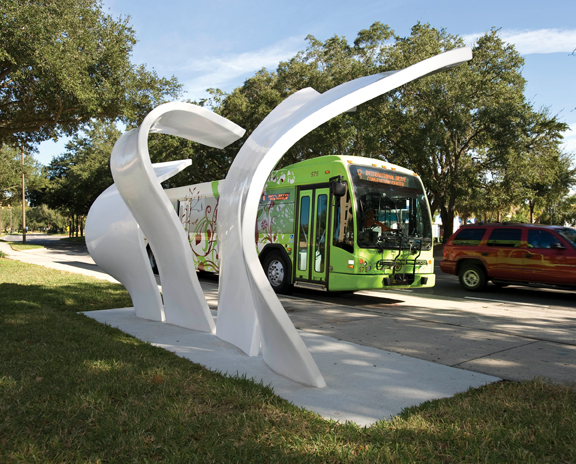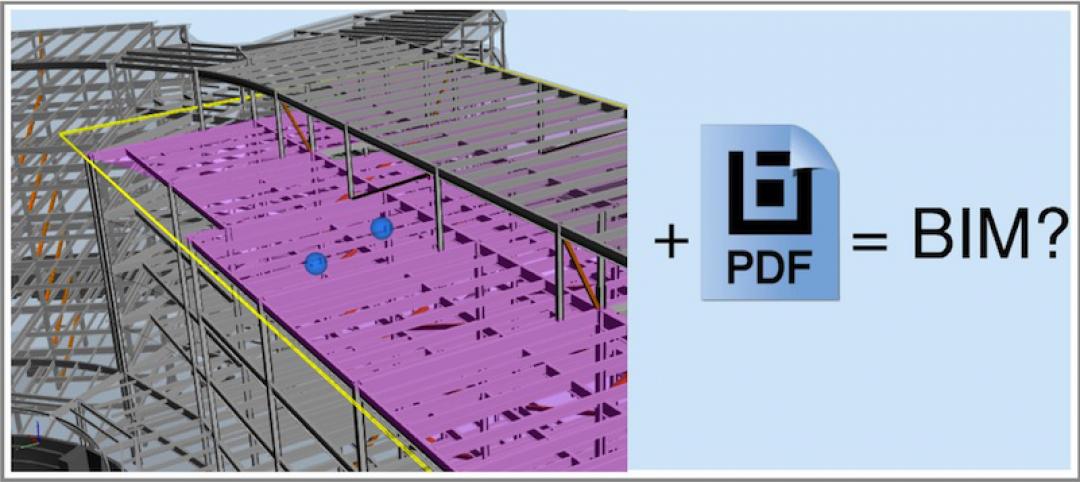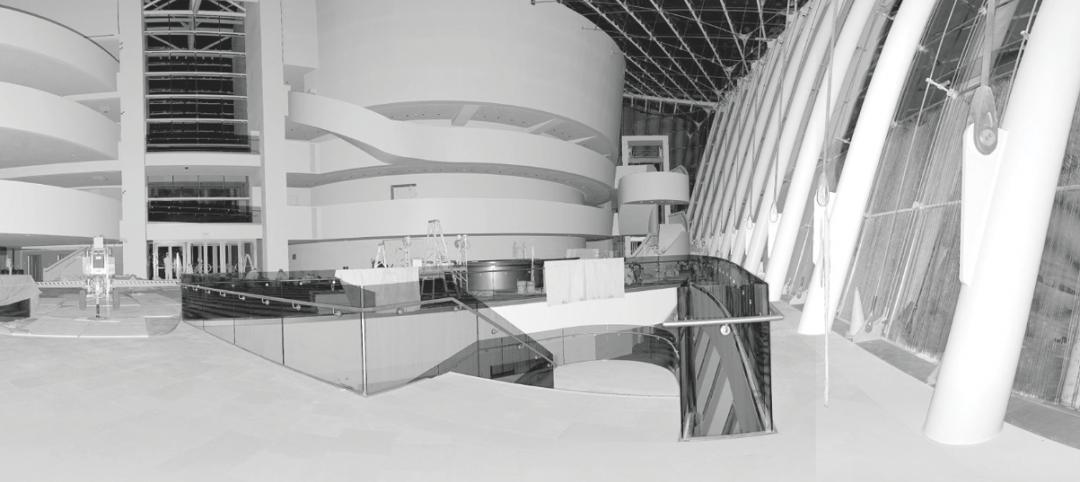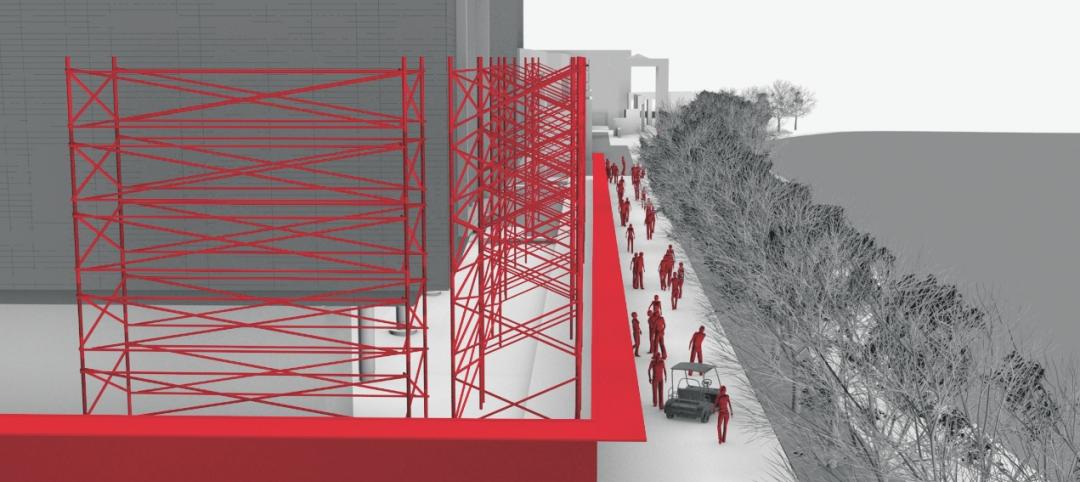ART SHELTERS
In Orlando, sculpture can be found in unexpected places
Public transit users in Orlando, Fla., can now wait for the bus in style. Entech Creative Industries, Walt Geiger Studios, and LYNX (Central Florida Regional Transportation Authority) have adorned four sites along International Drive with “art shelters,” concrete art installations that serve as bus shelters. The art forms are constructed of Entech EG 21 Series Formable Composite Panel. Artist Walt Geiger calls the shelters his “Cascade” collection. The largest includes five structures; the tallest reaches about 12 feet in height. The new shelters bring art to public spaces for bus riders who may never have the opportunity to go to art museums.
 WATER FILLING STATION
WATER FILLING STATION
Tap, tap, tap: Bottle-filling station saves on plastic waste
In 2010, total annual global bottled water consumption measured 8.75 billion gallons; the average American consumed 28.3 gallons of bottled water a year, according to the Bottled Water Association. Elkay’s EZH20 rapid bottle-filling station reduces the waste from manufacturing and disposing of plastic bottles. The filling station can be retrofitted to work with an existing water cooler or installed as a new unit. Its Green Ticker is a built-in visual mechanism that tracks the number of 16-ounce water bottles diverted from landfills. Recent applications: university campuses, airport terminals, and corporate campuses.
 SNAP-AND-GO TILES
SNAP-AND-GO TILES
Modular tiles turn boring office spaces into dynamic work areas
Working within a tight budget with not enough to invest in office décor? Ditto, from 3form, can help enliven any workspace without breaking the bank. Ditto is a modular product that uses cross-shaped pieces that snap together to create customizable partitions, wall features, and art pieces. An online configuration tool helps you design your own creations. Kits come with all the required hardware.
The snap-and-go pieces feature the high design flexibility of 3form’s Varia Ecoresin, a 40% pre-consumer recycled content with color, organic, sheer fabric, and resin properties.
 DECORATIVE GRASS
DECORATIVE GRASS
Move over, chia pet! Now it’s maintenance-free indoor grass
U.K-based media agency Curb has introduced urban greenery that needs no soil and can be used indoors. DesignGrass is 100% natural grass that can be made into any shape, pattern, image, brand, or word, from wallpapers and logos to temporary or permanent displays. It can be installed on indoor surfaces such as walls and ceilings. Once installed, it requires no watering or trimming.
The grass is being used to create green spaces in commercial or residential buildings for architectural or interior design purposes, and could be used for grass furniture, lights, and lampshades, according to Curb.
 OPEN TECHNOLOGY DATA PLATFORM
OPEN TECHNOLOGY DATA PLATFORM
Building management brought to you by the cloud
Occasionally, a more efficient approach to building also is more affordable for owners and operators seeking to achieve better building performance. Panoptix, by Johnson Controls, is an open technology platform that makes it easy for owners to collect and manage data from a wide variety of building systems and other data sources, such as meter and weather data. It provides a suite of cloud-hosted building efficiency applications that work with any building management system currently available to owners. Online and phone support, as well as onsite building and energy services, enables customers to implement operational improvements and energy-saving measures. There’s also an online connected community of peers and experts with whom to share best practices, ideas, and resources.
 SOLAR-POWERED PICNIC TABLE
SOLAR-POWERED PICNIC TABLE
Students can charge their electronic gadgets in the great outdoors of Washington, D.C.
Six students from the Catholic University of America in Washington, D.C., developed a solar-powered picnic table capable of charging laptops, cell phones, tablets, and other electronic devices. The design team included mechanical engineering graduate student Joseph Cochrane and five architecture and sustainable design graduate students: Lindsay Dickes, Michael Doster, Cory Estep, John Lang, and Monica Perez. Escaping the stuffy confines of the university library, students may now use the solar-powered outlets to charge laptops while studying for exams outdoors.
 ELECTRO-CONDUCTIVE WALLBOARD
ELECTRO-CONDUCTIVE WALLBOARD
Low-voltage surface lets you plug in your electronics anywhere in the room
What if, instead of plugging your electronics into an outlet, you could just plug them directly into the wall, anywhere in the room? That’s what the Electro-Conductive Gypsum Wallboard lets you do. A low-voltage surface on a gypsum board makes powering appliances convenient and cost-effective. Electrified wallboards consolidate direct current transformers, while a flexible conductive surface eliminates the need for utility power strips. The wallboard, by Eric Olson of Superficial Studio, utilizes a proprietary conductive thin-film matrix with high-efficiency, nonmagnetic transformers.
 SOLAR CARPORT
SOLAR CARPORT
Charging station can juice up to 13 vehicles a day
The 100 kW-hour solar carport was the result of a partnership between GE Energy Industrial Solutions and Inovateus Solar. The solar carport can generate enough energy to offset the power needed to charge up to 13 vehicles a day using six electric vehicle charging stations. The carport can also generate enough energy to power overhead lighting in the parking lot.
The solar carports are expected to pop up at universities, office buildings, and sports complexes around the country in 2012.
 LIGHTWEIGHT WALLBOARD
LIGHTWEIGHT WALLBOARD
15-30% lighter gypsum boards save lugging on the job
USG’s new Firecode 30 panel, a 5/8-inch board for nonrated and 30-minute fire-rated partitions, is up to 30% lighter than competitive panels. The company’s Firecode X panel is a 5/8-inch gypsum panel that weighs up to 15% less than competitive boards, meets ASTM C1396, and is listed for use in more than 130 UL fire-rated assemblies. According to the manufacturer, the lightweight panels score and snap easily, while also offering a high strength-to-weight ratio and improved sag resistance.
 ELECTRIC PAVING TILES
ELECTRIC PAVING TILES
Produce electricity just by walking on these pavers
Every footstep can be used to generate clean electric power. That’s the premise behind Laurence Kemball-Cook’s paving tiles, which he developed at England’s Loughborough University.
Each tile’s surface is made of recycled truck tires and a base of recycled polymer concrete. A footstep depresses the rubber surface by 1/5 of an inch, and the kinetic energy is then converted into electricity that can be stored, used immediately, or transmitted to a grid. According to Kemball-Cook, the energy generated during the day from about 10 tiles could power a streetlight all night long. The tiles can be used to retrofit existing flooring for both indoor and outdoor applications. BD+C
Related Stories
High-rise Construction | Mar 16, 2015
NBBJ creates 'shadowless' skyscraper concept for proposed UK development
A team of architects from the London branch of NBBJ used computer algorithms to generate a dual-tower design that maximizes sunlight reflections to eliminate the buildings' shadows.
BIM and Information Technology | Mar 11, 2015
Google plans to use robots, cranes to manipulate modular offices at its new HQ
Its visions of “crabots” accentuate the search-engine giant’s recent fascination with robotics and automation.
Museums | Mar 5, 2015
A giant, silver loop in Dubai will house the Museum of the Future
The Sheikh of Dubai hopes the $136 million museum will serve as an incubator for ideas and real designs—a global destination for inventors and entrepreneurs.
BIM and Information Technology | Mar 4, 2015
Why China's CCTV building needed a WiFi retrofit
It took a year-long retrofit to get WiFi transmission issues solved at China's iconic skyscraper.
Energy Efficiency | Mar 4, 2015
DOE launches crowdsourcing website for technology innovators
The Oak Ridge National Laboratory launched a new crowdsourcing website called the Buildings Crowdsoucing Community to collect and share ideas by innovators for energy-efficient technologies to use in homes and buildings.
Sponsored | BIM and Information Technology | Mar 3, 2015
The great debate: Is 3D PDF really BIM?
You can pull apart buildings, cut through floors, and view simulated animation for assembly instructions all within a PDF.
BIM and Information Technology | Feb 23, 2015
9 best practices for effective laser scanning
JE Dunn’s National BIM Director, Trent Nichols, offers tips and advice for mastering the art of laser scanning.
BIM and Information Technology | Feb 10, 2015
Google's 3D scanning camera leaves the lab
Google is said to be partnering with LG to create a version of the technology for public release sometime this year.
BIM and Information Technology | Feb 8, 2015
BIM for safety: How to use BIM/VDC tools to prevent injuries on the job site
Gilbane, Southland Industries, Tocci, and Turner are among the firms to incorporate advanced 4D BIM safety assessment and planning on projects.
















